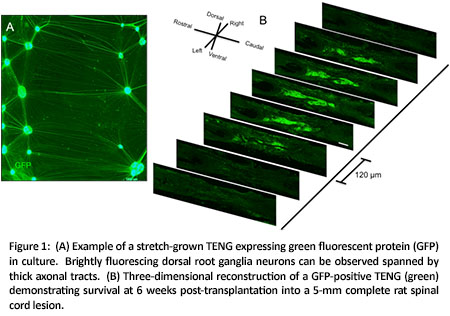


Posted June 10, 2014
Douglas Smith, M.D., University of Pennsylvania
 Spinal cord injury (SCI) is a major cause of morbidity and mortality in the United States. The need is urgent to develop treatments that will improve recovery and reduce the severity of long-term complications in individuals with SCI. A major challenge to repairing an injured spinal cord is in facilitating the surviving axons to grow across a lesion site - often filled with numerous inhibitory factors - and reconnect to neural networks on the other side.
Spinal cord injury (SCI) is a major cause of morbidity and mortality in the United States. The need is urgent to develop treatments that will improve recovery and reduce the severity of long-term complications in individuals with SCI. A major challenge to repairing an injured spinal cord is in facilitating the surviving axons to grow across a lesion site - often filled with numerous inhibitory factors - and reconnect to neural networks on the other side.
Dr. Douglas Smith's laboratory has developed a neural tissue engineering strategy, based on the natural process of "stretch growth of axon tracts," to transplant living nerve constructs that may serve as a bridge across the spinal cord lesion. Dr. Smith received a fiscal year 2009 Investigator-Initiated Research Award to test the feasibility of transplanting these tissue-engineered nerve grafts (TENGs) into spinal cord-injured rats for promoting axon growth across the lesion and inducing functional recovery. TENGs were evaluated in a 5-millimeter (mm) full transection SCI rat model, which demonstrated robust survival of the transplant and evidence of nerve regeneration across the TENGs as far as 6 weeks post-transplantation (Figure 1A). TENG axons were found to penetrate deeply into both sides of the host stump even in the presence of glial scarring (Figure 1B). In addition, there is evidence of host (rat) axon integration with and along the TENG axons, which may lead to the reconnection of impaired neural networks.
As expected, no statistical differences were found in functional recovery between the TENG transplant and control groups due to the relatively early time points. As the protocol and the TENGs themselves are optimized for increased viability and longevity, later time points will be tested for functional recovery. Future studies will also be directed towards resolving axon growth challenges as a result of glial scarring and cyst formation at the lesion site. Overall, TENGs show promise for promoting axonal regeneration and recovering intraspinal circuits across spinal cord lesions and, ultimately, for enhancing functional recovery.

Links:
Public and Technical Abstracts: Spinal Cord Repair with Engineered Nervous Tissue














